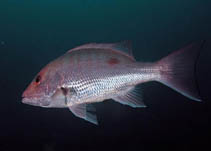| Family: |
Lutjanidae (Snappers), subfamily: Lutjaninae |
| Max. size: |
100 cm TL (male/unsexed); max.weight: 23 kg; max. reported age: 57 years |
| Environment: |
reef-associated; marine; depth range 10 - 190 m |
| Distribution: |
Western Atlantic: Gulf of Mexico and eastern coast of the USA extending northward to Massachusetts, coasts of Florida (Ref. 26938), but rare north of the Carolinas. Throughout Gulf of Mexico (Ref. 26938). This species has been referred to as Lutjanus aya by previous authors, but Rivas (Ref. 6409) proved that Bodianus aya Bloch, 1790 is not a lutjanid, but probably a sciaenid. |
| Diagnosis: |
Dorsal spines (total): 10-10; Dorsal soft rays (total): 14-14; Anal spines: 3-3; Anal soft rays: 8-9. Scale rows on back rising obliquely above lateral line. Specimens under 30 to 35 cm with large dark spot on the upper sides, located below the anterior soft dorsal rays. |
| Biology: |
Adults are found over rocky bottoms. Juveniles inhabit shallow waters, common over sand or muddy bottoms. Feed mainly on fishes, shrimps, crabs, worms, cephalopods, and some planktonic items including urochordates and gastropods. Marketed fresh and eaten steamed, broiled and baked (Ref. 9988). Heavily exploited in American waters where it is now closely protected; shrimp fishing, accused of destroying young snappers, is currently restricted. |
| IUCN Red List Status: |
Vulnerable (VU); Date assessed: 10 August 2015 (A2bd) Ref. (130435)
|
| Threat to humans: |
reports of ciguatera poisoning |
| Country info: |
|
Source and more info: www.fishbase.org. For personal, classroom, and other internal use only. Not for publication.

